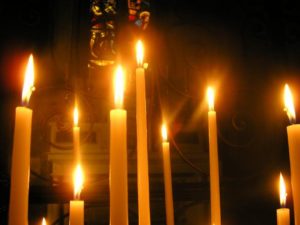 About fifteen years ago I happened to hear about an Eastern Rite Ukrainian Catholic Church a few towns over from where I was living at the time and I decided to attend Divine Liturgy one Sunday morning. I have always loved Eastern Rite Christianity with its beautiful sung liturgies, generous use of incense, holy water and continuous making of the Sign of the Cross throughout the service not to mention the churches themselves decorated from wall to wall with icons of Jesus and the saints which truly are windows into Heaven. This Sunday in particular happened to be the 2nd of February, the Feast of the Presentation, which commemorates when the child Jesus was presented at the temple in Jerusalem. At the service, the priest blessed a large basket of beeswax candles which the congregants then took to light in their homes and bring a blessing and dispel darkness from their lives. I found this tradition truly fascinating and it prompted me to do more research into this holy day popularly known as Candlemas observed by many denominations and dating back to the early days of Christianity yet containing symbolism borrowed from pagan religions. Today I would like to explore the rich folklore and wide variety of popular traditions associated with Candlemas.
About fifteen years ago I happened to hear about an Eastern Rite Ukrainian Catholic Church a few towns over from where I was living at the time and I decided to attend Divine Liturgy one Sunday morning. I have always loved Eastern Rite Christianity with its beautiful sung liturgies, generous use of incense, holy water and continuous making of the Sign of the Cross throughout the service not to mention the churches themselves decorated from wall to wall with icons of Jesus and the saints which truly are windows into Heaven. This Sunday in particular happened to be the 2nd of February, the Feast of the Presentation, which commemorates when the child Jesus was presented at the temple in Jerusalem. At the service, the priest blessed a large basket of beeswax candles which the congregants then took to light in their homes and bring a blessing and dispel darkness from their lives. I found this tradition truly fascinating and it prompted me to do more research into this holy day popularly known as Candlemas observed by many denominations and dating back to the early days of Christianity yet containing symbolism borrowed from pagan religions. Today I would like to explore the rich folklore and wide variety of popular traditions associated with Candlemas.
 Candlemas has been celebrated in the Christian church since as far back as the 3rd century AD. By the Middle Ages the day also came to celebrate the purification of the Virgin Mary after giving birth to Jesus as was the Jewish custom of the day. Candlemas shares much in common with pre-existing Pagan observances that were celebrated at the same time of year. In Rome, mid-February marked the feast of Lupercalia celebrating Lupercus the Roman god of fertility. Curiously, elements of Lupercalia also became part of Valentine’s Day celebrations in later centuries. In Celtic lands, in early February they observed Imbolc which celebrated the lengthening days and heralded the coming spring season. On this day, farmers would carry torches across their fields in honor of the goddess Brigid and ask her to bless and purify the land before spring planting. The symbolism of light surrounding this day carried over into Christian observances and the blessing and lighting of candles became intrinsically linked to the Feast of the Presentation as can be seen in its popularly known name: Candlemas. The lighting of candles during this feast came to symbolize the victory of light over darkness and the drawing in of peace and blessings to our lives.
Candlemas has been celebrated in the Christian church since as far back as the 3rd century AD. By the Middle Ages the day also came to celebrate the purification of the Virgin Mary after giving birth to Jesus as was the Jewish custom of the day. Candlemas shares much in common with pre-existing Pagan observances that were celebrated at the same time of year. In Rome, mid-February marked the feast of Lupercalia celebrating Lupercus the Roman god of fertility. Curiously, elements of Lupercalia also became part of Valentine’s Day celebrations in later centuries. In Celtic lands, in early February they observed Imbolc which celebrated the lengthening days and heralded the coming spring season. On this day, farmers would carry torches across their fields in honor of the goddess Brigid and ask her to bless and purify the land before spring planting. The symbolism of light surrounding this day carried over into Christian observances and the blessing and lighting of candles became intrinsically linked to the Feast of the Presentation as can be seen in its popularly known name: Candlemas. The lighting of candles during this feast came to symbolize the victory of light over darkness and the drawing in of peace and blessings to our lives.
 In various parts of the Christian word there are many popular traditions associated with Candlemas. Perhaps nowhere it is more a part of the popular culture than in the Brittany region of France where it is known as la Chandeleur. This day is associated with the preparation of crêpes, the light thin pancakes often filled with both sweet and savory fillings for which Brittany is famous and by extension are popular in all of France. This tradition likely has its origins in the fact that the crêpe resembles the sun and Candlemas is a celebration of light which heralds the coming spring. Also, Pope Gelasius I gave pilgrims arriving in Rome for Candlemas pancakes to welcome them, a tradition which may have carried over to modern times in Brittany. A popular practice states that if you flip a crêpe with your right hand while holding a coin in your left, you will have good luck for the year to come. Also a crêpe is often kept inside an armoire all year round for protection, good luck and prosperity. Mysteriously, this crêpe is said to never get moldy and remain perfectly preserved until the next Candlemas. In addition to these ancient traditions, Candlemas is an occasion to spend time with family and loved ones and pause to enjoy the lengthening of days and anticipate the coming of spring.
In various parts of the Christian word there are many popular traditions associated with Candlemas. Perhaps nowhere it is more a part of the popular culture than in the Brittany region of France where it is known as la Chandeleur. This day is associated with the preparation of crêpes, the light thin pancakes often filled with both sweet and savory fillings for which Brittany is famous and by extension are popular in all of France. This tradition likely has its origins in the fact that the crêpe resembles the sun and Candlemas is a celebration of light which heralds the coming spring. Also, Pope Gelasius I gave pilgrims arriving in Rome for Candlemas pancakes to welcome them, a tradition which may have carried over to modern times in Brittany. A popular practice states that if you flip a crêpe with your right hand while holding a coin in your left, you will have good luck for the year to come. Also a crêpe is often kept inside an armoire all year round for protection, good luck and prosperity. Mysteriously, this crêpe is said to never get moldy and remain perfectly preserved until the next Candlemas. In addition to these ancient traditions, Candlemas is an occasion to spend time with family and loved ones and pause to enjoy the lengthening of days and anticipate the coming of spring.
 There are also many traditions surrounding the weather that are associated with Candlemas dating back to the Middle Ages. In central Europe, especially in Germanic lands, bears traditionally come of out hibernation in early February to test the weather and forage for food. If they are particularly active and visible, people took it as a sign that there would be an early spring. This this is the origin of the modern Groundhog Day traditions brought to Pennsylvania by German immigrants where it is believe that if the groundhog sees his shadow there will be six more weeks of winter and if there is no shadow then spring will come early. Groundhog Day coincides with Candlemas falling on February 2nd. In Poland, as elsewhere in the Christian world, candles are blessed on Candlemas and a popular folk belief holds that if these candles are burned during a storm the blessing that they impart will help ward off misfortune and prevent damage bought about by the storm.
There are also many traditions surrounding the weather that are associated with Candlemas dating back to the Middle Ages. In central Europe, especially in Germanic lands, bears traditionally come of out hibernation in early February to test the weather and forage for food. If they are particularly active and visible, people took it as a sign that there would be an early spring. This this is the origin of the modern Groundhog Day traditions brought to Pennsylvania by German immigrants where it is believe that if the groundhog sees his shadow there will be six more weeks of winter and if there is no shadow then spring will come early. Groundhog Day coincides with Candlemas falling on February 2nd. In Poland, as elsewhere in the Christian world, candles are blessed on Candlemas and a popular folk belief holds that if these candles are burned during a storm the blessing that they impart will help ward off misfortune and prevent damage bought about by the storm.
Anyone who has been following my blog and my facebook page will know that Halloween is by far my favorite holiday so it will come as no surprise that my favorite tradition associated with Candlemas is Liichtmëssdag which comes from Luxemburg and bears a striking resemblance to trick-or-treating. On the night of February 2nd costumed children go door to door carrying lanterns and asking for treats while singing songs celebrating this day. This tradition, especially with the symbolism of the lanterns, no doubt has its origin in an ancient ritual celebrating the lengthening of the days.
I hope you have enjoyed reading about this special holiday and I thank you for taking the time to read my blog. I wish you peace, happiness and abundant blessings in these days of lengthening daylight and always!